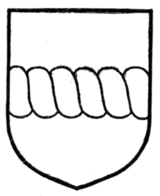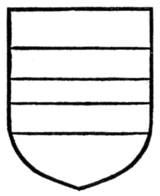A fess wreathed (Fig. 112) is a bearing which seems to be almost peculiar to the Carmichael family, but the arms of Waye of Devon are an additional example, being: Sable, two bars wreathed argent and gules. I know of no other ordinary borne in a wreathed form, but there seems no reason why this peculiarity should be confined to the fess.
It is a fixed rule of British armory that there can be only one fess upon a shield. If two figures of this character are found they are termed bars (Fig. 113). But it is hardly correct to speak of the bar as a diminutive of the fess, because if two bars only appear on the shield there would be little, if any, diminution made from the width of the fess when depicting the bars. As is the case with other ordinaries, there is much latitude allowed to the artist in deciding the dimensions, it being usually permitted for these to be governed by the charges upon the fess or bars, and the charges between which these are placed.
Bars, like the fess, are of course equally subject to all the varying lines of partition (Figs. 114-118).
The diminutive of the bar is the barrulet, which is half its width and double the width of the cottise. But the barrulet will almost invariably be found borne in pairs, when such a pair is usually known as a "bar gemel" and not as two barrulets. Thus a coat with four barrulets






